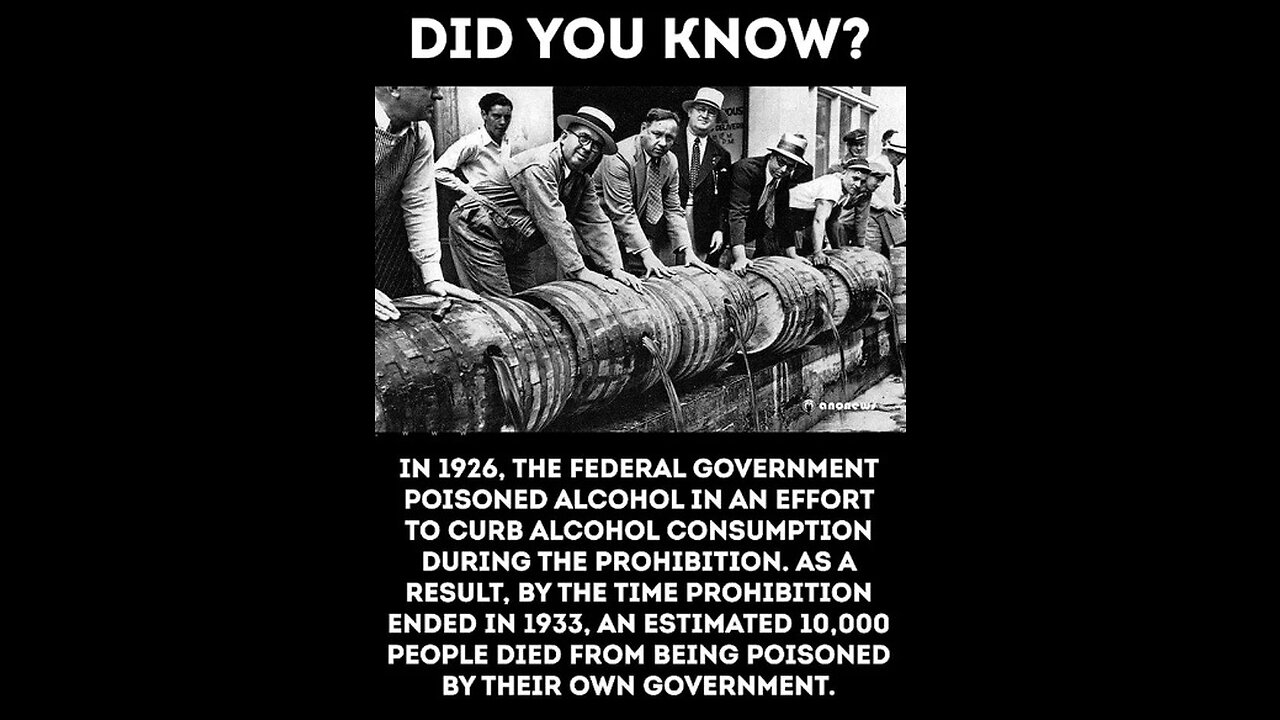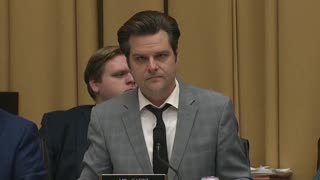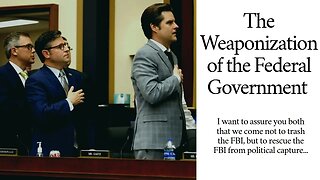Premium Only Content

How U.S. Government (Killed Us Again) U.S.A. Poisoned Alcohol During Prohibition
Almost everyone knows that the United States government sometimes operates in the shadows, but have you ever heard of how the U.S. government poisoned alcohol during prohibition? This event costed 10,000+ dead people their lives perished from such poisoning and hundreds of thousands more suffered irreversible injuries including blindness and paralysis . When the manufacture and sale of alcohol was illegal between 1920 and 1933, regulatory agencies encouraged measures making 60 Million Gallons industrial alcohol undrinkable, including the addition of lethal chemicals.
(The government did not poison supplies of alcohol meant for human consumption, nor did it intentionally aim to kill those who drank the tainted products.) This Statement Above From U.S.A. Is Not True... U.S. Government Did Purposely Poison and Done It On Purpose To Ten's of Million U.S. Americans Citizens During Prohibition 60 Million Gallons A Year Stolen Industrial Alcohol... Stolen Really ? How by a model T or A car or maybe by chain drive or worm drive truck ?
To Sell 60 Million Gallons the stolen industrial alcohol, (Stolen?) the liquor syndicates employed chemists to "renature" the products, returning them to a drinkable state. The bootleggers paid their chemists a lot more than the government did, and they excelled at their job. Stolen and redistilled alcohol became the primary source of liquor in the country. So federal officials ordered manufacturers to make their products far more deadly.
By mid-1927, the new denaturing formulas included some notable poisons—kerosene and brucine (a plant alkaloid closely related to strychnine), gasoline, benzene, cadmium, iodine, zinc, mercury salts, nicotine, ether, formaldehyde, chloroform, camphor, carbolic acid, quinine, and acetone. The Treasury Department also demanded more methyl alcohol be added—up to 10 percent of total product. It was the last that proved most deadly.
It wasn't just the violent Prohibition-era gang wars that were dangerous to Americans drinking homemade moonshine and bathtub gin. According to the Dec. 26, 1922 edition of the New York Times, five people were killed in the city on Christmas Day from drinking "poisoned rum." That was only the beginning. By 1926, according to Prohibition, by Edward Behr, 750 New Yorkers perished from such poisoning and hundreds of thousands more suffered irreversible injuries including blindness and paralysis. On New Year's Day 1927, 41 people died at New York's Bellevue Hospital from alcohol-related poisonings. Oftentimes, they were drinking industrial methanol, otherwise known as wood alcohol, which was a legal but extremely dangerous poison. One government report said that of 480,000 gallons of liquor confiscated in New York in 1927, nearly all contained poisons.
It was Christmas Eve 1926, the streets aglitter with snow and lights, when the man afraid of Santa Claus stumbled into the emergency room at New York City's Bellevue Hospital. He was flushed, gasping with fear: Santa Claus, he kept telling the nurses, was just behind him, wielding a baseball bat.
Before hospital staff realized how sick he was—the alcohol-induced hallucination was just a symptom—the man died. So did another holiday partygoer. And another. As dusk fell on Christmas, the hospital staff tallied up more than 60 people made desperately ill by alcohol and eight dead from it. Within the next two days, yet another 23 people died in the city from celebrating the season.
Frustrated that people continued to consume so much alcohol even after it was banned, federal officials had decided to try a different kind of enforcement. They ordered the poisoning of industrial alcohols manufactured in the United States, products regularly stolen by bootleggers and resold as drinkable spirits. The idea was to scare people into giving up illicit drinking. Instead, by the time Prohibition ended in 1933, the federal poisoning program, by some estimates, had killed at least 10,000 people.
The intent of Prohibition was to deter the consumption of alcohol, which was seen as unhealthful and a public nuisance. Not only would that prove nearly impossible to achieve, but the government’s zeal to block the consumption of industrial alcohol would lead to the unintentional but disastrous poisoning, paralysis and deaths of thousands of drinkers at the hands of bootleggers. And in 1930, a pair of men in Boston would concoct an illegal and toxic alcoholic beverage, “Ginger Jake,” that was responsible for crippling up to 100,000 people across America.
The Volstead Act contained two significant exceptions to its ban on the sale of alcohol – liquors dispensed by doctors as prescription medicine (typically whiskey and other hard liquor) and liquors produced and used for religious sacraments (usually wine) by priests, rabbis and ministers.
Section 7 of the Volstead Act permitted alcoholic beverages as a treatment by a doctor who “in good faith believes that the use of such liquor as a medicine by such person is necessary and will afford relief to him from some known ailment.” The law also left itself open to misuse by letting doctors prescribe alcohol even if they could not physically examine the patient, as long as their off-site diagnosis was based “upon the best information attainable.”
That Volstead made the exception for doctors to prescribe and pharmacists to dispense “medicinal liquor” as therapy for the sick went against even the prevailing view of the medical profession at the time. In 1917, the American Medical Association issued a declaration stating that alcohol had no “scientific value” as a tonic or stimulant for healing and “should be further discouraged.” Still, the dubious and outdated view of alcohol as a remedy — a tradition going back thousands of years — was codified in the law and would prove lucrative for both doctors and druggists and an excuse for “patients” to score booze from 1920 to the end of Prohibition in 1933.
Volstead specified that doctors had to obtain a permit from the U.S. Treasury Department to prescribe alcohol, which was manufactured for pharmacies by government-approved distilleries. The department issued pads of numbered and watermarked forms to doctors who could then sign prescriptions allowing patients up to one pint of liquor (usually whiskey) every 10 days. The medicine was costly – the patient had to pay about $3 ($37.50 in 2016 dollars) to the doctor for the diagnosis and another $3 to the pharmacist. Volstead specifically prohibited refills (although not separate prescriptions) and made druggists write in a date that “canceled” the prescription immediately after filling it.
Doctors typically prescribed one ounce of whiskey to adults (less for children, who also were treated with liquor) every few hours for maladies with formal names such as “la grippe” (the flu), “coryza” (the common cold) and “pharyngitis” (sore throat) but also for serious ailments such as high blood pressure, heart disease, depression, tuberculosis and cancer, with the rationale that liquor promoted digestion and physical vigor.
The legal exemption led to a windfall for doctors and pharmacists. Even the AMA, just two years after Prohibition started, rescinded its objection to the medicinal value of liquor, endorsing it as a treatment for a laundry list of nearly 30 ailments. For the Walgreens drug company of Chicago, the popularity of medicinal alcohol sent profits through the roof – the chain grew from 20 drugstores in 1920 to 525 stores across the country in 1929. But Walgreens to this day insists its rapid growth was due to a combination of effective management, its tasty brand of ice cream made in Chicago served in its stores’ soda fountains, and specifically the invention of the malted milkshake by its employee, Ivar “Pop” Coulson, in 1922.
For years before Prohibition, industrial-grade (and undrinkable) alcohol was used in factories as a solvent and cleaning fluid, and to manufacture detergent, flavoring extracts and perfumes. Alcohol had been subject to excise taxes as a beverage in the United States until 1906, when a process borrowed from Europe added “denaturants,” or substances that made grain-based (ethyl) alcohol taste or smell bad, to deter its use in drinks. The “denatured” alcohol could then be used, tax free, in manufacturing.
By the start of Prohibition in 1920, tens of millions of gallons of denatured ethyl alcohol were made for industrial use and considered legally exempt by the U.S. government because it contained toxic additives rendering it dangerous to drink. The alcohol was denatured by mixing it with wood (methyl) alcohol, a harmful liquid that could cause blindness or death if ingested. But bootleggers started using denatured industrial alcohol disguised as whiskey – what would be called “rotgut” for its effect on the drinker’s internal organs – even in the months before Prohibition took effect. The magazine Literary Digest, in its January 10, 1920 issue, reported that scores of people had recently died, including 57 in Hartford, Connecticut, and hundreds of others blinded after drinking “alleged whiskey” containing wood alcohol. Authorities arrested some bootleggers after tracing the tainted alcohol to New York City.
By about 1922, supplies of authentic whiskey distilled prior to Prohibition, and targeted for theft by bootleggers, were gone. With industrial alcohol being made on a large scale, bootleggers starting hijacking it, figuring they could redistill and sell it as drinkable alcohol. By 1923, the Treasury Department’s Prohibition Bureau was already focused on preventing organized crime from reconditioning industrial alcohol for sale to drinkers. The government instructed makers of the industrial-use liquid to denature it by adding four percent wood alcohol, poisonous to humans in very small amounts.
But bootleggers nonetheless succeeded in stealing large quantities to recondition it into cheap booze for unsuspecting drinkers, often those in the lower classes who could not afford high-quality liquor. The government reported that by the mid-1920s, about 90 million gallons of alcohol for industrial use had been distilled nationally with about 6 million reserved for medical and research purposes and the rest meant for hundreds of commercial businesses. However, the government estimated that bootleggers had grabbed about 10 million gallons. Bootleggers, knowing full well it contained wood alcohol, attempted to remove the toxins by boiling the grain and wood alcohol mixture in illegal stills. The wood alcohol boiled and started to evaporate into a condenser at 151 degrees Fahrenheit, while it took 173 degrees to boil the grain liquid. Some of the poisonous wood liquid evaporated but as the public would later learn, it was not chemically possible to take out all the wood alcohol. Even a small amount of wood alcohol remaining, if ingested, attacked the nervous system, for instance, the optic nerve, causing blindness.
In the mid-1920s, bootleggers sold large amounts of the poisonous alcohol mixed with other liquids, represented it as whiskey and other beverages, and people started dying. In New York in 1926, about 750 perished after imbibing the wood alcohol-laced bootlegged liquor. That New Year’s Eve, as people drank in 1927, many jammed Bellevue Hospital on New Year’s Day and 41 died. Hundreds more New Yorkers died later that year. In Philadelphia, 307 died that January, and 163 in Chicago. About 15,000 people were reported poisoned in just one county in Kansas. Up to 50,000 people may have died from the repurposed industrial alcohol nationwide and thousands of others were stricken by crippling paralysis. In 1927 in New York alone, of the 480,000 gallons of liquor seized by Treasury’s Prohibition agents, 98 percent contained poisonous additives, and liquor seized from 55 of the city’s speakeasies proved to contain traces of wood alcohol.
Critics, including anti-Prohibition “wets,” blamed the deaths and injuries on reckless government policies, such as the absence of warning labels on containers of industrial alcohol. Dr. Nicolas Murray Butler of Columbia University accused the U.S. government, which approved the wood alcohol denaturant, of “legalized murder.” The government acted by passing a new law lowering the maximum wood alcohol content in industrial alcohol to two percent. In the weeks after the disaster in 1927, J.M. Doran, head chemist for the Prohibition Bureau, worked on perfecting a new, less harmful but still foul-smelling and tasting denaturant, such as kerosene. The feds later approved the addition of ingredients such as iodine, ether, nicotine and formaldehyde to try to make industrial alcohol too horrible to drink.
By 1930, when the earnings of America’s bootleggers hit an estimated $3 billion, criminal distributors had for some time shifted from industrial alcohol to distilling their own raw alcohol with sugar, yeast and other ingredients, producing yields considered good enough and safe to drink. But also that year, another national wave of alcohol poisoning loomed, this time without government involvement.
In 1928, a pair of Boston bootleggers, brothers-in-law Harry Gross and Max Reisman, began manufacturing a version of Jamaica Ginger, a popular patent medication used for stomach ailments, colds and malaria. Jamaica Ginger, often called “Ginger Jake,” had been manufactured since the 1860s and drank recreationally in dry counties and states even before federal Prohibition. Alcohol-based medicinal tonics such as Jamaica Ginger were obtainable legally during Prohibition, but only if manufacturers added a high percentage of bittering agents, such as ginger oleoresin, to discourage people from drinking them.
Gross and Reisman sought to produce something that mimicked the chemical effects of oleoresins without effecting the taste. The men added as adulterant the chemical tri-ortho-cresyl phosphate, known as Lindol. The odorless, tasteless chemical was a plasticizer used to make celluloid film and explosives. Gross and Reisman said they were assured by the manufacturer that Lindol was safe. The men circulated about 1,000 gallons of the stuff from 1929 to 1930. It was shipped into Rhode Island and Georgia and eventually sold from coast to coast. But Lindol proved to be toxic to nerve cells, causing paralysis — mostly permanent — below the waist. It quickly produced an epidemic of damage to the legs of drinkers. From 35,000 to 100,000 people were afflicted with a pronounced, slow limp called “jake leg” or “jake walk.” Many of the injured were poor, immigrants or African-Americans.
Gross and Reisman were prosecuted not under the Volstead Act but the Agriculture Department’s food and drug laws for producing a fake product. Both were convicted of felony crimes and sentenced to two years in prison. Gross went to prison but Reisman’s sentence was suspended. For decades to come, those with “jake leg” could be seen limping and begging on the streets of large cities. But they received little sympathy as many believed what happened to them was their own fault.
-
 1:25:52
1:25:52
What If Everything You Were Taught Was A Lie?
6 days agoAmerica Is Collapsing Today Bible Text Is Not What You Think No Church No Religion No Synagogue
1.56K2 -
 6:41
6:41
SweetHomeStAugustine
2 years agoPeru Government Reopens Rail During Protest
48 -
 5:09
5:09
The Post Millennial Live
2 years agoMatt Gaetz during the Weaponization of the Federal Government hearing
4516 -
 9:52
9:52
bethevoicegen1rev22
2 years agoAlcohol Deaths Increase During Pandemic, In The UK.
22 -
 5:14
5:14
Rightell
2 years agoMatt Gaetz, During The Weaponization Of The Federal Government Hearing
15 -
 6:42
6:42
KimKarcrashian
2 years agoUK government invite you to get poisoned
38 -
 13:30
13:30
joegecko
2 years agoAnimals DROPPING DEAD All over Ohio After Government POISONED Town | PETA Silent!?
44 -
 1:45
1:45
mistersunshinebaby
2 years agoGovernment Forced Businesses To Close During Freedom Convoy
33 -
 5:15
5:15
BOSSPREPAREDNESS
2 years agoyou will run to the government for help during SHTF
18 -
 13:30
13:30
Shari2020
2 years agoAnimals DROPPING DEAD All over Ohio After Government POISONED Town
28